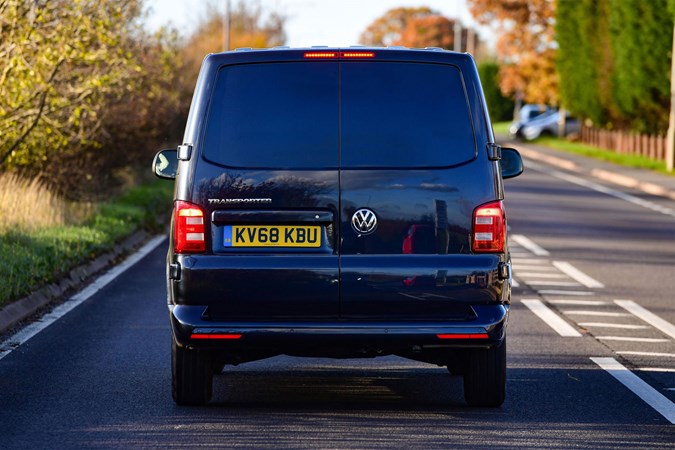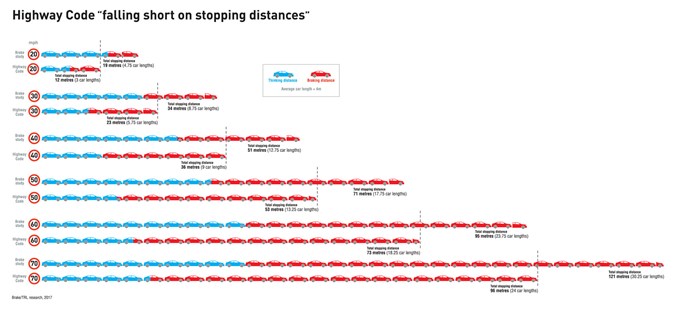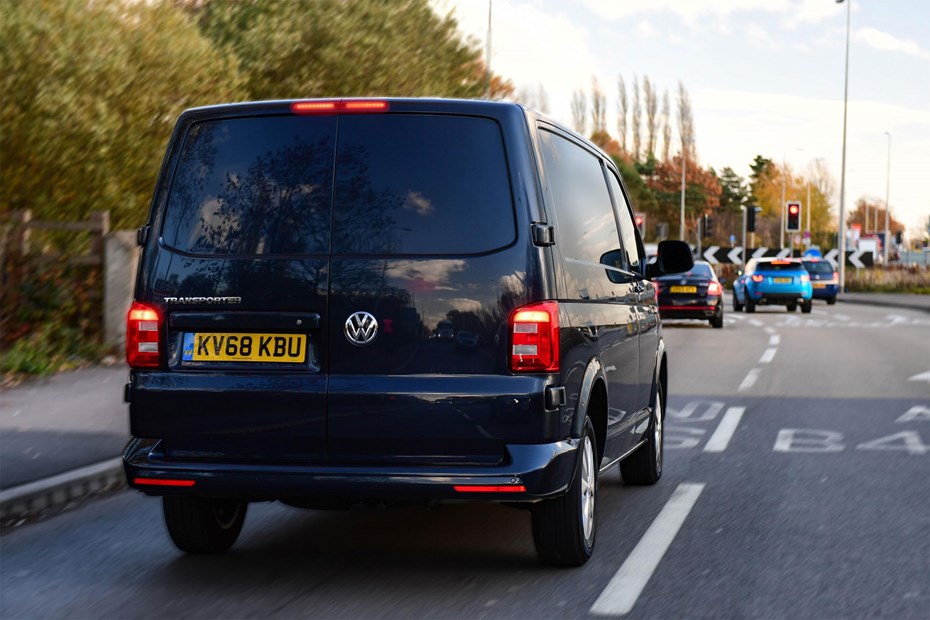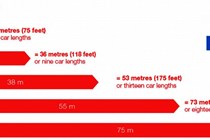Do you know how long it takes to stop your van in an emergency? Or how much that braking distance changes when the van is loaded compared with when it’s unloaded? According to research undertaken by Volkswagen Commercial Vehicles, the difference could be 33%. That’s a third.
At 30mph, the increase works out to be a stopping distance two metres longer, while at 60mph stopping takes an extra five metres – that’s about the length of a VW Transporter.
How did VW test van braking distances?
Volkswagen took a Caddy small van, a Transporter medium van and a Crafter large van to the MIRA Proving Grounds in Nuneaton, and measured how long it took each vehicle to stop from 30mph and 60mph, when empty and while carrying a 500kg test weight.
Adding half a tonne – well within the payload capacity of most vans on UK roads; many will carry two or three times that much – saw braking distances increase by 33% at 30mph and 19% at 60mph.

That means the loaded vans travelled an average of two metres further when stopping from 30mph, and an average of five metres further when braking from 60mph.
| Stopping distance speed | Percentage increase with 500kg load | Metres increase with 500kg load |
| 30mph | 33% | two metres |
| 60mph | 19% | five metres |
What about vans travelling at higher speeds or with even greater payload?
While VW didn’t test at any other speeds or weights, the research clearly suggests the faster you go and the heavier the van, the longer it will take to stop and the further it will travel in that time.
What can I do to try to avoid accidents when travelling in a heavily loaded van?
As heavily loaded vans take longer to stop, you need to leave a greater distance between you and the vehicles in front.
This will give you more time and space to safely bring the van to a halt in an emergency.
Is there any technology that can help maintain a safe stopping distance in a van?
Yes – many modern vans come equipped with technology that can help you avoid this kind of accident, although it is not always fitted as standard.
For example, many brands now offer adaptive cruise control on vans, which automatically maintains a set distance to the vehicles in front. Ford even has a system that can automatically adjust the cruise control to match the speed limit. Clever.
Other vans – notably the most recent models from the PSA Group, such as the Citroen Dispatch and Berlingo, Peugeot Expert and Partner, and the latest Vauxhall Combo – are available with a distance warning system, which tells you if you’re getting too close to the vehicle in front.
This system doesn’t account for the weight of the van, however. But the new Berlingo, Partner and Combo are also available with an overload sensor, which can tell you when the van is exceeding its legal payload rating. A helpful addition measure for maintain braking safety.

Finally, an increasing number of vans are available with autonomous emergency braking (AEB), which can reduce reaction times and improve the effective use of the van’s full braking power. Commendably, VW has been fitting AEB as standard on all its UK vans since mid-2017.
Speaking of full braking power, often drivers don’t hit the brakes hard enough, even in an emergency. Most modern vans have very effective ‘electronic brakeforce distribution’ (EBD) systems that can radically reduce stopping distance, but you really need to slam the brake pedal hard to get the most from this.
Just don’t try that in an older van, especially one that doesn’t even have an anti-lock braking system (ABS).
What are the official van braking distances according to the Highway Code?
The UK’s Highway Code doesn’t separate its braking distance advice for cars and vans, simply giving one set of figures.
According to VW’s research, only 17% of van drivers could correctly identify the stopping distance for 30mph, so we’ve reproduced the Highway Code’s official information below:
| Speed | Thinking distance | Braking distance | Total stopping distance | Car lengths |
| 20mph | 6 metres | 6 metres | 12 metres | 3 |
| 30mph | 9 metres | 12 metres | 23 metres | 6 |
| 40mph | 12 metres | 24 metres | 36 metres | 9 |
| 50mph | 15 metres | 38 metres | 53 metres | 13 |
| 60mph | 18 metres | 55 metres | 73 metres | 18 |
| 70mph | 21 metres | 75 metres | 96 metres | 24 |
Here’s the same info in graphic form as well:

Keep in mind, however, that the average working van is likely to be heavier than the average car, and that as VW’s research shows, the heavier a vehicle is, the longer it takes to stop.
And besides which, not everyone believes the Highway Code figures are accurate, anyway…
Are the Highway Code stopping distances correct?
Road safety charity Brake believes the Highway Code’s stopping distance figures are incorrect, and we should all be leaving even more room for braking safely.
Working with the Transport Research Laboratory (TRL) , Brake has concluded the average thinking time when reacting to an emergency braking situation is 1.5 seconds – more than double the 0.67sec used in the Highway Code calculations.
If that’s true, braking distances would be considerably further – see the table below for comparison (all figures are total stopping distances combining thinking and braking distances):
| Speed | Brake/TRL study | UK Highway Code | Difference |
| 20mph | 19 metres | 12 metres | 7 metres |
| 30mph | 34 metres | 23 metres | 11 metres |
| 40mph | 51 metres | 36 metres | 15 metres |
| 50mph | 71 metres | 53 metres | 18 metres |
| 60mph | 95 metres | 73 metres | 22 metres |
| 70mph | 121 metres | 96 metres | 25 metres |
Brake has also provided a handy graphic, which shows you the distances involved in car lengths, making it easier to visualise the difference and the space required to stop.

Be safe out there.
Also read:
>> VW vans fits autonomous emergency braking as standard
>> Van reviews on Parkers Vans and Pickups
>> More van advice on Parkers Vans and Pickups
Just so you know, we may receive a commission or other compensation from the links on this website - read why you should trust us.












